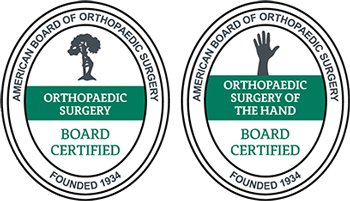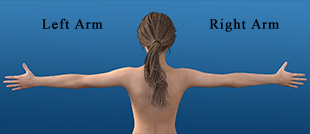Metacarpal Fractures
Contents
What is a Metacarpal Fracture?

A metacarpal fracture is a type of hand fracture occurring in the bones which form the palm of the hand. These bones, located between the bones of the wrist and the bones of the fingers, are called the metacarpals. There are five metacarpal bones, each articulating with a digit of the hand. They are described by Roman numerals. Metacarpal I is the bone in the palm which connects to the thumb, and metacarpal V corresponds to the bone of the little finger, or “pinky”. These five bones are shaped like long, thin rods and are very delicate. As a result, the metacarpals are prone to fracture.
The metacarpals can fracture at any location along their length or ends. There are, however, some locations more commonly fractured than others. One type of metacarpal fracture, the Boxer’s fracture, occurs at the neck of the metacarpal bone closest to the end that forms the knuckle. A boxer’s fracture usually involves metacarpal V, but can occur in metacarpals 2-4 as well.
Bennett’s and Rolando’s fractures involve the first metacarpal bone. Bennett’s fracture occurs at the base of the first metacarpal where it articulates with the carpal bones of the wrists. In Rolando’s fracture, the same metacarpal base is fractured, but a Y shaped split results in a comminuted fracture, where the bone has fractured into multiple small pieces.
What causes a Metacarpal Fracture?
Metacarpal fractures are almost always a result of trauma. Boxer’s fractures are most commonly caused by striking an object with the knuckles of a clenched fist. Rolando’s fracture is caused by force applied to the metacarpal base while the thumb is tucked within the fist, from either an awkward fall or from striking a fixed object in that position. Bennett’s fracture occurs when the hand is clenched in a fist and the metacarpal is partially flexed, as occurs in a fall from a bike where the hand is wrapped around the bike handle. It can also result from a fall onto the thumb. The fifth metacarpal shaft can be fractured by a direct blow as would be seen in a “karate chop”.
What are the symptoms of a Metacarpal Fracture?
Tenderness, pain, and swelling over the affected area are the hallmarks of a metacarpal fracture. In a Boxer’s fracture, the symptoms will be present at the affected knuckle joint. The knuckle may also appear depressed and range of motion at the knuckle may be limited or occur with a popping sensation. Bennett’s and Rolando’s fractures will present with symptoms overlying the base of the thumb at the wrist. A Bennett’s fracture will show pain and bruising and instability at the junction of the metacarpal with the wrist. Grip strength will be severely limited. Rolando’s fracture presents simply with pain and swelling at the carpometacarpal joint. Fractures of the metacarpal shaft will present with localized pain and swelling.
How is a Metacarpal Fracture Diagnosed?
The mechanism of injury is an important part of the history that will establish suspicion for a metacarpal fracture. Plain radiographs are useful for initial evaluation of a metacarpal fracture but may not be able to show the nuances of a Bennett’s or Rolando’s fracture. CT and possibly fluoroscopy may be needed to properly diagnose these fractures. Likewise, Boxer’s fracture may also need advanced imaging studies such as CT.

How is a Metacarpal Fracture Treated?

Treatment of metacarpal fractures may involve both non-surgical and surgical interventions.
Non-Surgical
The majority of Boxer’s fractures will not need surgical treatment. They can usually be reduced and splinted in the emergency department with follow up care arranged with a hand surgeon. Splints are typically worn for six weeks, followed by physical therapy.
Bennett’s fractures can sometimes be treated with closed reduction followed by immobilization in a thumb spica splint. If the reduction cannot be maintained or if the fracture is otherwise unstable, surgical intervention will be needed. Rolando’s fractures will need surgical treatment unless there are many pieces like an broken eggshell that are not amenable to fixation.
Surgical
A Boxer’s fracture will need surgery if the wound is open, or if repair of a ligament or tendon is needed. Other indications for surgery with a Boxer’s fracture include severe levels of displacement or lesser levels of displacement in the second or third metacarpal. Open reduction and internal fixation with plates, pins, or screws is the procedure of choice. This is followed by splinting and a course of physical therapy once the bones have healed.
Bennett’s fractures can usually be treated by closed reduction with the placement of K wires to pin the bone fragments into place, followed by immobilization in a cast for approximately six weeks while the fracture heals. If this approach fails, open reduction with internal fixation will be used.
Rolando’s fractures with several large fragments will require open reduction and internal fixation. Usually some combination of K wires, plates and screws will suffice to reduce the fracture, but if this fails an external fixator may be needed. Casts or fixators will remain in place for approximately 6 weeks while the fracture heals.
How can Dr. Knight help you with Metacarpal Fractures?
Dr. Knight welcomes you to any of our Dallas Fort-Worth accessible hand and wrist offices. Dr. Knight is an accomplished hand specialist. Come to our Southlake office or Dallas office today and bring life back to your hands.
Videos
Animated Videos
Disclaimer
HandAndWristInstitute.com does not offer medical advice. The information presented here is offered for informational purposes only. Read Disclaimer

























